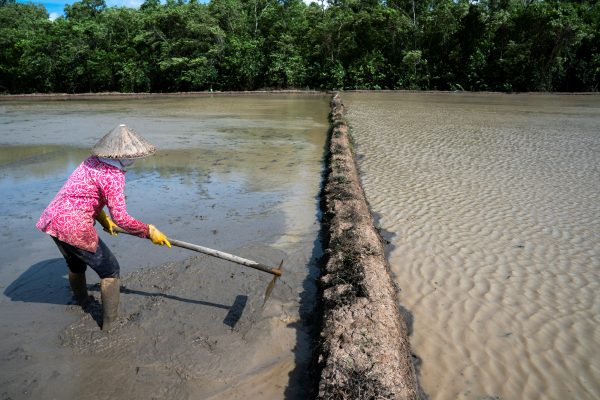Water scarcity shapes how agrarian communities interact with water ecosystems. In both flooding and salinity-affected zones of the delta, extreme water scarcity over the past few years has amplified hardships in managing water for crop production and have eroded the efforts to build sustainable water-dependent livelihoods.
Risks of water alterations in the VMD can be largely attributed to the transboundary and in-situ impacts of upstream hydropower development and climatic events. The storage of water by large-scale hydropower dams in China is perceived to be the key driver of substantial water fluctuations in downstream countries.
This is evidenced by the high variations in flood peaks over the past two decades, which reveal how water resources managed and distributed in one provincial jurisdiction have effects on others, sometimes thousands of kilometres away. Managing water locally within historical flood regimes requires a consideration of profoundly non-local decisions and processes.
While the Vietnamese government has endeavoured to implement climate resilient and sustainable development strategies as mandated by Resolution 120, mounting pressures have persistently been placed on rural societies as they deal with seasonal water scarcity on the ground. Resolution 120 seeks to develop an overall development agenda that embraces long-term visions, objectives and solutions towards improving the regional economy while prioritising adaptation to climate change. Yet amid these laudable objectives, scant attention is devoted to addressing water scarcity and security over the immediate and long terms.
There are widespread concerns that the key drivers of water scarcity may be impending. Attempts to control floods in support of intensive rice production have led to the building of large-scale embankment systems and lateral canal networks to drain floodwater out to the West Sea. Emerging water challenges facing the VMD suggest that such ‘techno-fixes’ are failing to retain a large volume of floodwater in the delta while leveraging risk of saltwater intrusion in the West coast.
Emerging water challenges in the VMD are also prompting an ongoing transition in water management, from water expulsion to water retention. This indicates a shift of attention by the Vietnamese government from floodplains to coastal zones, which are perceived to be particularly exposed to the impacts of climate change, including saltwater intrusion. On the ground evidence suggests that, unlike their counterparts living in the floodplains who have accumulated a deep knowledge and experience of living with floods, those living in coastal areas are still learning and struggling to respond to local environmental changes.
While climate–development externalities in the Mekong region remain unabated, water retention presents the most realistic approach to deal with current water scarcity. But water retention solutions initiated by local governments are predominantly technical. Water disruptions, in tandem with high demands for agricultural irrigation, have pushed local governments to build large-scale on-field reservoirs which are believed to be the best approach to dealing with water scarcity. While these solutions provide a rationale for local governments to exercise their political agenda towards meeting productivist agricultural development goals, questions of implementation, efficiency and effectiveness remain.
Demands for water retention in the VMD suggest that ‘grey–green’ solutions, composed of both ‘grey’ engineering-based and ‘green’ natural capital approaches, may be more sustainable. While grey solutions such as dykes and reservoirs remain essential to retaining water on a large scale, the non-dyke areas of the delta and wetland systemsmay be surprisingly effective in absorbing and storing large amounts of floodwater during the flood season.
Policies that support the blending of such ‘grey–green’ approaches offer an important adaptive pathway to future water security. Integrating these hybrid approaches into the water governance framework will provide important pathways towards achieving water sustainability and agricultural development over the long term.
To secure water in the VMD, the Vietnamese government needs to actively engage in water diplomacy at the regional scale and translate these efforts into water management policies at the delta scale to better address emerging and future water insecurity. While the delta remains exposed to mounting pressures at multiple scales, both transboundary and in-situ, integrated ‘grey–green’ solutions may be the most viable option to securing water sustainability for the successful implementation of climate-resilient development demanded by Resolution 120.
Thong Anh Tran is a Research Fellow at the School of Geography, Earth and Atmospheric Sciences, The University of Melbourne. He is also an Honorary Lecturer at Fenner School of Environment and Society, The Australian National University.

